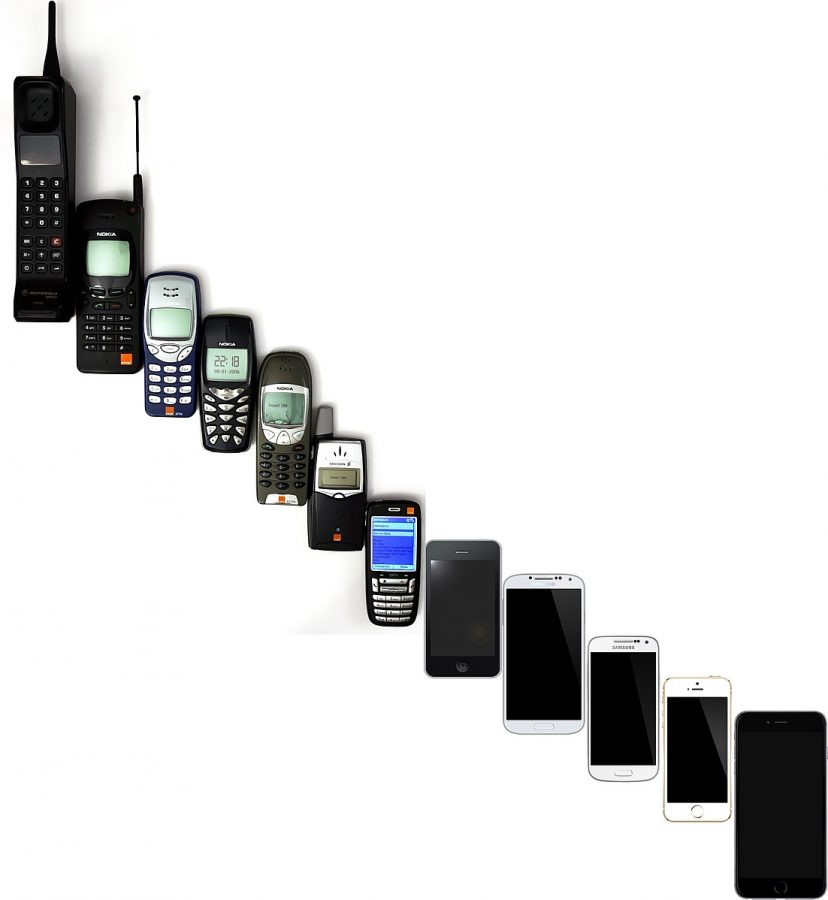iPhone 8 vs. Galaxy S8
Wikimedia Commons
The phone has evolved throughout the past two decades, with the Apple iPhone 8 and the Samsung Galaxy S8 emerging as two of the premier present-day smartphones. In every category including price, display, battery life, processing speed, camera capabilities, and unique features – the Samsung Galaxy S8 trumps Apple’s iPhone 8.
February 5, 2018
Ever since the insurgence of smartphone devices, there has been an enduring debate surrounding the choice between the two evident technology giants and leading competitors in the mobile industry – Samsung and Apple. The question surrounding which company sports a better device has prompted both tech giants to push new limits in design and innovation. Just ten years ago, the iPhone 3G was released which ushered in the modern era of mobile capability. It was a small 4.5-inch phone that allowed users to do everything a typical mobile phone could, however, the world was introduced to the now famed “app store.” The app store changed everything and created a personalized experience that was not previously possible. Entwined with the fact the iPhone 3G at the time had unrivaled built-in storage and it indeed set the stage for future Apple market dominance. Jump forward ten years later to the current year 2018, and we have smartphones with 240gb+ of storage, fingerprint scanners, 2960×1440 curved displays, octa-core processors, 12-megapixel lens, and the list goes on. With so many iPhone and Samsung devices existing today, it can certainly be intimidating when shopping for a new device and spending nearly a thousand dollars. As such this analytical article will compare the new iPhone 8 and Galaxy S8 base model phones from each respected competitor to break down the baseline question that is asked by almost every single smartphone owner today; should I purchase an Apple or Samsung device? The obvious choice is a Samsung, and I’m going to be diving into the reasons why a Samsung phone reigns superior to the Apple device.
The first and arguably most crucial category that should be compared before delving into specific features and technical aspects is device price. Regarding the Samsung Galaxy S8, the typical retail price one could expect to pay today without a contract is around $750. On the other end of the spectrum, a new unlocked Apple iPhone 8 with no contract will run you around $930 for the base model. With this in mind, the clear winner in terms of pricing would be the Samsung Galaxy S8 coming in at almost $200 less than the iPhone 8. The next most important factor that one must consider when purchasing a new mobile phone is the battery life and storage that you will be getting with the phone. On a daily basis, we continually store and share pictures, videos; surf the internet, and download applications. Smartphones need to be able to hold these large amounts of data only to be practical. Both the iPhone 8 and Samsung Galaxy S8 have base models which come with 64GB of storage space. Both, however, can be upgraded to 256GB of storage space. This makes both device’s storage capabilities virtually identical. As for battery life, there is not much discrepancy either as the iPhone 8 can typically last for around ten hours on a full charge while the Galaxy S8 can usually last for about eleven hours on a full charge.
A smartphone’s display size and resolution are often one of its best-selling features. Nobody in 2018 wants a phone screen that is incapable of immersion, and as such, the mobile devices which are seen on the market today often sport large and high-resolution displays. The iPhone 8 and Galaxy S8 are of course no exception. The iPhone 8 has a resolution of 1334×750 with a 4.7-inch LCD display. The Galaxy S8, on the other hand, has a much higher resolution 2960×1440, 5.8-inch screen. Evidently, the Samsung Galaxy S8 also comes out with the edge in this pivotal category.
Processing power is another essential aspect of any technological device, and smartphones are no different. We have certainly come a long way since the iPhone 3G, as the iPhone 8 sports an A11 Bionic processor with the Galaxy S8 operating on a Snapdragon 835 processor. Numerous benchmarking tests in the past have shown that the Galaxy S8’s Snapdragon 835 processor runs at around a 1.5x faster clock speed than the A11 Bionic, making it the likely victor. As for the device’s cameras which are integral in producing bright and crisp photos, the iPhone 8 and Galaxy S8 both have 12-megapixel rear lenses. However, the Galaxy S8 has an aperture of (f/1.7) while the iPhone 8 has an aperture of (f/1.8). Although they are only off by 0.1, the smaller the aperture, the better the photos turn out with low light conditions; giving the Galaxy S8’s 12-megapixel camera a slight advantage over its rival.
The last and arguably most subjective aspect for grounds of comparison is the device’s physical aspects and unique features. The iPhone 8 weighs approximately .02 lbs less than the Galaxy S8. However, the Galaxy S8 is marginally bigger coming in at 5.9 x 2.7 inches while the iPhone 8 is 5.5 x 2.7 inches. As for special features, the iPhone 8 has wireless charging, is water resistant, has a dual-domain display, an aforementioned fingerprint scanner, and more. On the other hand, the Galaxy S8 features infinity display, force touch, wireless charging, Samsung connect, Bixby, a fingerprint scanner, and so on. As a result, we see the Samsung Galaxy S8 exceed its rival once again.
In every category including price, display, battery life, processing speed, camera capabilities, and unique features – the Samsung Galaxy S8 trumps Apple’s iPhone 8. The iPhone 8 is ever so slightly lighter than the Galaxy S8; however, the Galaxy S8 sports a taller and higher resolution display. With this in mind and the fact that the Galaxy S8 is almost $200 cheaper than the iPhone 8, the choice should be easy and clear-cut.


















![“[Building nerf blasters] became this outlet of creativity for me that hasn't been matched by anything else. The process [of] making a build complete to your desire is such a painstakingly difficult process, but I've had to learn from [the skills needed from] soldering to proper painting. There's so many different options for everything, if you think about it, it exists. The best part is [that] if it doesn't exist, you can build it yourself," Ishaan Parate said.](https://harkeraquila.com/wp-content/uploads/2022/08/DSC_8149-900x604.jpg)




![“When I came into high school, I was ready to be a follower. But DECA was a game changer for me. It helped me overcome my fear of public speaking, and it's played such a major role in who I've become today. To be able to successfully lead a chapter of 150 students, an officer team and be one of the upperclassmen I once really admired is something I'm [really] proud of,” Anvitha Tummala ('21) said.](https://harkeraquila.com/wp-content/uploads/2021/07/Screen-Shot-2021-07-25-at-9.50.05-AM-900x594.png)







![“I think getting up in the morning and having a sense of purpose [is exciting]. I think without a certain amount of drive, life is kind of obsolete and mundane, and I think having that every single day is what makes each day unique and kind of makes life exciting,” Neymika Jain (12) said.](https://harkeraquila.com/wp-content/uploads/2017/06/Screen-Shot-2017-06-03-at-4.54.16-PM.png)








![“My slogan is ‘slow feet, don’t eat, and I’m hungry.’ You need to run fast to get where you are–you aren't going to get those championships if you aren't fast,” Angel Cervantes (12) said. “I want to do well in school on my tests and in track and win championships for my team. I live by that, [and] I can do that anywhere: in the classroom or on the field.”](https://harkeraquila.com/wp-content/uploads/2018/06/DSC5146-900x601.jpg)
![“[Volleyball has] taught me how to fall correctly, and another thing it taught is that you don’t have to be the best at something to be good at it. If you just hit the ball in a smart way, then it still scores points and you’re good at it. You could be a background player and still make a much bigger impact on the team than you would think,” Anya Gert (’20) said.](https://harkeraquila.com/wp-content/uploads/2020/06/AnnaGert_JinTuan_HoHPhotoEdited-600x900.jpeg)

![“I'm not nearly there yet, but [my confidence has] definitely been getting better since I was pretty shy and timid coming into Harker my freshman year. I know that there's a lot of people that are really confident in what they do, and I really admire them. Everyone's so driven and that has really pushed me to kind of try to find my own place in high school and be more confident,” Alyssa Huang (’20) said.](https://harkeraquila.com/wp-content/uploads/2020/06/AlyssaHuang_EmilyChen_HoHPhoto-900x749.jpeg)










